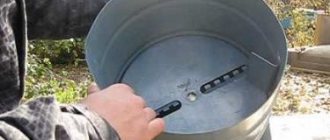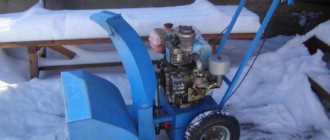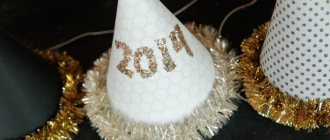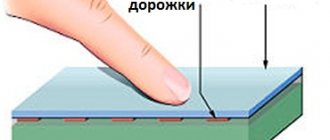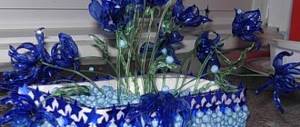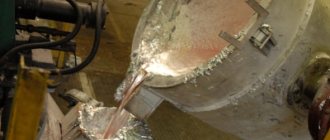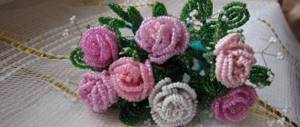Mini aquarium
We have all dreamed of having fish at least once. It’s so nice to watch their calm and measured life. However, not everyone decides to have a large aquarium, and there are many reasons for this, for example:
- lack of funds for its purchase and maintenance;
- lack of space for location;
- lack of knowledge in the field of aquarium husbandry;
- protest from the other inhabitants of the house, etc.
A completely acceptable alternative would be a mini aquarium, which takes up very little space and does not require complex care. Pet stores in the city offer a completely satisfactory range of this type of aquarium, but they are all standard and a little boring. Alternatively, there is a very real opportunity to make a mini aquarium with your own hands. Let's look at the main stages that you will need to go through if you decide to make a mini aquarium yourself.
How to make a mini aquarium?
You need to stock up on transparent silicone, glue, glass, any degreaser and perseverance. Think over, or better yet, outline the dimensions of the proposed structure. Remember that for the fish to fully inhabit, the volume should not be less than 4 liters. If such an aquarium is too large for you, then you should think about replacing the fish with beautiful algae or shells. So, the sketch is ready. Use a glass cutter to cut the glass into the required size pieces. Degrease the edges with acetone or another solvent and glue. After drying, carefully seal the seams with transparent silicone and let them dry thoroughly. The accuracy and aesthetics of the final product directly depends on how slowly the work is done. It is better to make a round mini aquarium from a transparent vase of the required size and shape.
Soil and plants for a mini aquarium
The finished aquarium has dried, now you need to take care of its design. The soil can be any type of aquarium stones, previously boiled in a weak solution of potassium permanganate. Of course, it is better to choose pebbles of original shape and color. The landscaping will be plants for a mini aquarium and algae, which are small in size and will not take up space for the fish to live. In some cases, it makes sense to use a special decorative film that imitates an underwater landscape or plastic aquarium plants.
Lighting and mini filter for aquarium
Making your own mini aquarium with lighting is not difficult. It is enough to build a lid from glass, plastic or other material and equip it with a light bulb, a powerful diode and a battery - and let there be light!
It is worth understanding that equipping this type of aquarium with all types of devices will greatly reduce its aesthetic qualities. If your pet requires constant water purification, it is worth purchasing and installing a small filter or compressor for a mini aquarium. There will be no need to purchase the latter if the inhabitants of the aquarium are fish that can breathe atmospheric air. You may also need a mini aquarium pump and pump. Their purchase also entirely depends on the needs of the “settlers” for living conditions. Installing them is not particularly difficult.
A tabletop mini aquarium is an ideal option for a desktop in an office or in a student’s room. This piece of furniture can create an atmosphere of peace and tranquility, create conditions for concentration or, conversely, provide an opportunity for distraction.
Marine mini aquarium. The maintenance and arrangement of this type of aquarium requires a high degree of responsibility, care and resources. There is a need to constantly add water, comply with the necessary temperature changes, certain lighting and water composition.
Many people have thought about purchasing the most silent pets - fish. But they require an aquarium, which can take up a lot of space and be expensive. In small apartments or offices this can be a problem. Therefore, in this article we will look at small options.
WomanAdvice.ru>
DIY glass aquarium
If you decide to get fish or change your aquarium, you will definitely need tips on how to make an aquarium from available materials.
Making an aquarium with your own hands - general rules
There are 2 ways to assemble a rectangular aquarium: all edges rest on the bottom or are attached around it. The latter option is suitable for containers larger than 50 liters. Select the thickness of the glass in accordance with the dimensions of the future container. This table will help with this:
For this purpose, you need to choose silicate (ordinary) glass. Glass can be window (polished) or showcase (mirror). Window material often has a surface with bumps and waves, is less durable, but costs less. The display surface is made with calibrating polishing, which makes the product very durable and of high quality. Pay attention to the type of glass: M1 (highest) to M8 (lowest). The better the marking, the fewer foreign elements in the form of bubbles will be in the walls of the aquarium. You can use used display glass.
Make the cut in such a way that the front walls correspond to the dimensions of the container itself. The bottom needs to be reduced in both parameters by two thicknesses of the selected glass, add a few mm of glue. The end part is equal in height to the front elements and equal in width to the bottom.
Do-it-yourself plexiglass aquarium: progress of work
- In order to make a beautiful aquarium with your own hands measuring 400x300x240 mm, you will need 2 front glasses 300x400 mm, a canvas 390x230 mm for the bottom, the ends have dimensions 300x230. The lid will be 380x220 mm, its holders will be 2 glasses 180x30 mm. If the capacity is impressive, stiffening ribs will be required (at least ¾ of the longest side). They are attached to the top of the facing panels, which will prevent them from bending outward.
- After cutting, sand the bevels with sandpaper. Remember that you cannot treat the sides on which the sealant will be applied. Otherwise, the elements simply will not stick together.
- Here is silicone glue, glass and masking tape. Use masking tape to cover the glass along the contour of how the glue will be applied. This approach will prevent you from staining everything around with glue. A distance equal to the thickness of the glass plus a couple of millimeters is retreated from the edge. We get:
- The bottom is covered on 4 sides.
- Go over the ends with a lint-free cloth with acetone or alcohol. After this, apply 2 drops of glue on each side of the bottom and on the vertical part of the ends. After 2 hours, cut off the drop, leaving 1-2 mm - this will be the thickness of the binder between the glasses. This makes gluing the walls easier. They should not touch each other.
- Choose a hard, flat surface as a working area: carpet or sofa are not suitable. Glue the front wall to the bottom. To make it easier to fix, use a jar of water.
- Next, glue the end part at an angle of 90 degrees, masking tape will help with this.
- Now we need to work on the second end, the last one in line will be the rear window.
- All excess glue is removed using a cloth with vinegar.
- Apply adhesive tape around the perimeter of the upper part of the structure, this makes it possible to properly fasten the seams.
- After a few hours, it is recommended to go over all connections with silicone. This is a mandatory procedure for large containers; if you are making a small aquarium with your own hands, this is not necessary.
- Allow the glue and silicone to cure for 12, or preferably 24, hours.
- When the entire structure is dry, remove the adhesive tape and clean the seams with a blade. If necessary, attach stiffeners and holders.
- It's time to check. Fill the aquarium to the top to check the seams for integrity. Attach paper to them, it will immediately show punctures, if any. If the seam is not perfect, pour out the water, dry the seam and use silicone and a needle to correct the flaw.
- Rinse the aquarium and let your pets into it.
WomanAdvice.ru>
A small aquarium and everything you need to know about it.
What aquariums are considered small?
Aquariums with a volume of less than 30-40 liters are considered small, usually from 5 to 20 liters. They are often called nanoaquariums (from the Greek nano - “small, tiny, dwarf”), emphasizing with this term not only their size, but also their modernity and manufacturability. There are also microaquariums, their capacity is 1-2 liters, and animals are not allowed in them, with the exception of some types of snails. The world's smallest fish aquarium was created by Omsk miniaturist Anatoly Konenko and his son Stanislav. They placed soil, a specially designed mini-compressor, small Cladophora bushes and several zebrafish fry in 10 ml of water.
Let’s immediately agree that we will not call a round ten-liter jar with a goldfish a nanoaquarium, since this is not an aquarium, but a mockery of fish and all the principles of aquarium management.
An aquarium, no matter what size it is, is an equilibrium biological system whose inhabitants feel comfortable.
Achieving this in a small volume is a whole science. But if this is successful, the results can be simply amazing. Such aquariums, where a living biotope is reproduced in a tiny volume, are reminiscent of the Japanese art of bonsai or scale models of luxury cars: small, but everything is real.
Of course, not all small aquariums are worthy of aquascaping competitions or books of records, but any of them should please the eye of its owner and create a comfortable environment for its inhabitants.
Mini aquarium care
As for keeping a small aquarium, here you can fall under the influence of stereotypes. Parents often buy aquariums for their children, believing that a small aquarium is easier to care for than a large one. Rather, on the contrary, the “underwater world” of a small size is subject to temperature changes and requires frequent water changes.
If the water is changed rarely, fish waste products begin to accumulate on the walls and it will be quite difficult to clean the container with your hands. In addition, the slightest excess of food lying at the bottom of such an aquarium instantly spoils the water and shifts the biological balance. But if you decide to have a small aquarium, buy it “fully equipped”. Specialists will select all the necessary equipment for lighting, water filtration and water heating. And, despite the equipment, place the aquarium in a room where the temperature is constant.
With such a small amount of water, a difference of even 1-2 degrees has a negative effect on the fish. When feeding your fish, allocate a small amount of food so that there is no leftover after feeding. Remove excess feed immediately. When caring for an aquarium, you will have to change the water frequently until the bacteria stabilize in the filter.
Bacteria convert waste decomposition products into harmless substances. A supply of settled water should always be at your disposal. The water in the aquarium should be changed every three to four days, replacing at least a quarter of the volume of water in a small aquarium.
To prevent the appearance of algae, the aquarium should not be placed close to a window. Direct sunlight should not fall on it, and it is advisable to gradually increase the duration of active daylight hours from six hours immediately after setting up the aquarium to ten hours by the time the biological balance has stabilized.
Small aquarium and equipment for it
Nanoaquariums have a rectangular, cubic or similar shape. They are usually covered with a transparent cover glass, which allows them to be admired from above. They are located away from drafts and direct sunlight and closer to the outlet that will be needed to connect the equipment.
The equipment for nanoaquariums is generally the same as for large ones, that is, a filter (in some cases a pump with an aerator is sufficient), lighting fixtures, a heater if necessary, preferably complete with a thermostat, and a carbon dioxide supply system.
For those who do not have the experience and time to select aquarium equipment, fully equipped nanoaquariums are available for sale. The Aqua El Shrim Set and Dennerle Nano Cube series complexes are recognized as the best in terms of price and quality ratio.
And if you want to save money or are interested in choosing all the filling for your nanocube yourself, there is plenty to choose from.
Filter
For a small aquarium, a filter is vital. Since the balance in this system is very fragile, and a small deviation in the parameters of aquarium water can be fatal for its inhabitants, it is necessary to reduce the risk of these fluctuations as much as possible. Therefore, pumps without a sponge or with a small sponge the size of a matchbox are not suitable. Or rather, they can be used, but only in aquariums with a very large number of living plants and without fish, with only invertebrates. However, with such a population, you can do without a filter at all or limit yourself to a compressor.
If there are fish in the aquarium, the requirements for the filter are very serious. It should have a large filler surface to create biofiltration, pass 8-15 aquarium volumes per hour, but not create strong flows of water that will damage plants, fish and crustaceans. In addition, small inhabitants of the aquarium should not enter its water intakes. And, of course, it should take up minimal space in the aquarium or be well decorated and fit into the landscape. Another optional, but very desirable condition is that the filter material should be removed from the water for rinsing without dismantling the filter itself; this greatly facilitates maintenance of the aquarium.
The following types of filters partially or fully satisfy these conditions:
- Internal filters with open sponges. They do not have a body, therefore, no one will be sucked into them. A large sponge (it is better to immediately replace it with a finely porous one) serves as a good material for mechanical cleaning and a substrate for the growth of biofilter bacteria. Some models of such filters can be placed with the sponge facing up, so it can be easily removed.
- External mounted waterfall filters. They take up little space, since the main part is located outside. They have a fairly large volume that can be filled with various filter materials. They do not create a strong current. The disadvantages are that when using these filters the aquarium cannot be closed with a lid. A sponge or fine mesh must be placed on the water intake tube of such a filter to avoid aquarium inhabitants being sucked into the filter.
- External canister filters. Currently, models designed for small volumes have appeared. Provide very good mechanical and biological filtration without taking up space in the aquarium. As with mounted filters, the water intake tube must be covered with a sponge or mesh. The only drawback is the high cost.
In addition to these models, in small-volume aquariums you can use various home-made designs - airlifts, Hamburg filters, plastic bottles with a fibrous or porous substance connected to a pump. There is only one requirement: water under pressure must pass through a sufficient volume of material that provides mechanical filtration and can serve as a substrate for bacteria participating in the nitrogen cycle.
An additional filter in a small aquarium is live plants, sometimes they are even placed in a hanging waterfall, making it a phytofilter.
Lighting
Due to the mandatory presence of living plants, the issue of lighting a small aquarium becomes relevant. There, lamps built into the lid are almost never used; the lamps are installed at a certain height above the aquarium. Fluorescent or LED lamps are usually used. In general, the rule is this: if the lamps are fluorescent, then for unpretentious plants the light should be 0.5 W per liter of water, for fastidious ground cover or those with a reddish tint - 1 W per liter. If the lamps are LED, then the ratio of lamp power and luminous flux is different, and here they already look at the number of lumens. For undemanding plants, illumination of 25 lm per liter is sufficient, for demanding plants - 50 lm.
What kind of fish is suitable for a mini aquarium?
What fish can be kept in mini aquariums? Pets with miniature body sizes should be placed in a small 10-20 liter tank. Fish 2-6 centimeters in length will tolerate this volume of water. But remember that even small fish want to swim in a spacious environment. They should not be kept in containers that will restrict movement. Territorial and aggressive fish should not be placed in mini aquariums. Which ones should not be placed in 10-liter aquariums? These are swordtails, medium-sized barbs, cichlids, gourami, and zebrafish. They have an active and energetic disposition and require more hiding space.
In an aquarium of 10-20 liters you can put small barbs, Gertrude pseudomugil, rice fish, cherry barbs, rasbor, erythrozonus, neon, Amanda tetra. You can also keep the following fish and shrimp there: otocinclus catfish, corydoras, amano shrimp, cherry shrimp, copper tetra. Representatives of the genus Poeciliaceae, viviparous fish, get along well in mini tanks.
You need to buy fish breeds with strong immunity, that is, not purebred fish, but hybrids. If you do not have the opportunity to buy a spacious “house” for your small pet, you need to buy a small aquarium with a capacity of 10 liters. The well-known Siamese cockerels are also often housed there. The cockerel can live alone and does not get along with its relatives; it is a fighting fish, after all.
We carefully study the compatibility of species
Fish for a small aquarium should be selected depending on many factors. For beginners, it is problematic to take them into account on your own, so contact professionals who will help you determine which fish can be kept together and which ones should be avoided.
Factors important when moving in:
- Ability to survive alone. Some species can only live in flocks, so pay attention to this point first;
- Water characteristics for species should be approximately the same;
- The peaceful nature of the inhabitants;
- The number of individuals depends on the surface area of the water. The larger the footage, the more fish you can have;
- Breed compatibility. Sometimes individually peaceful fish cannot tolerate each other's proximity.
It is important to remember that small aquariums are a high-risk area for fish. Therefore, the choice of neighbors will completely determine the fate of your charges. If you add predatory fish to a small aquarium, they will eat their peace-loving neighbors. Gouras are suitable for angelfish; other fish will not get along with them. You can get one fish that will be the owner of your pond, or keep a whole flock of miniature fish.
PLANTS IN A MINI AQUARIUM
Live plants are needed in small aquariums, as they help remove dangerous substances from the water - nitrites, nitrates and ammonia. Plants in a mini-aquarium provide additional insurance and reduce stress in fish. They are also very convenient for growing some small species of plants, because in a mini-aquarium it is easier to create good lighting, but in large ones the light simply does not reach the lower level in the required quantities.
To choose the right plants for your aquarium, read materials on the Internet and talk to experienced sellers, they will always help.
FEEDING
The most important point. The food you feed is the main source, and in some cases even the only one, of various breakdown products. The less you feed, the less dirt and the more stable the aquarium. Of course, the fish must be well-fed, and your task is to maintain a balance between well-fed fish and overfed fish.
A good way is to give as much food as the fish eat in a minute, so that none of the food falls to the bottom. Commercial fish food, in the form of flakes, is a good choice for a small aquarium, it sinks slowly and produces less waste, but also produces small waste and they do not need to be fed excessively. It is better to feed the fish in a new aquarium with it. When the balance is established, or you have bottom-dwelling fish, such as catfish, you can add other types of food for a complete diet.
Decorating a small aquarium
You can decorate a nanoaquarium in different styles. Popular among aqua designers are the styles of iwagumi—decorated with stones of various shapes, rayuboku—decorated with driftwood, and wabikus—in the form of a hummock with plants. But here the taste and preferences of the owner are decisive. For example, if an aquarium is in a child’s room, it is quite appropriate to place a mermaid’s castle or a sunken ship and toy scuba divers in it. The main thing is that the decorations do not take up too much space (as a general rule, no more than a quarter of the bottom surface and half the height), hide the aquarium equipment and leave room for plants and fish. In addition, if there are shrimp in the aquarium, you must keep in mind that any objects protruding from the water can contribute to their escape from the aquarium.
The soil in small aquariums is usually used in two layers: the bottom layer is a nutrient substrate, the top layer is gravel, the total thickness of the layer should be 3-4 cm.
HOW TO MAKE AN AQUARIUM WITH YOUR OWN HANDS AT HOME.
LARGE AQUARIUM FOR HOME - LAUNCH DESIGN EQUIPMENT PHOTO VIDEO.
AQUARIUMS AND EVERYTHING YOU NEED TO KNOW ABOUT THEM.
aquarium-fish-home.ru>
